
Apamea sordens, the rustic shoulder-knot or bordered apamea, is a moth of the family Noctuidae. The species was first described by Johann Siegfried Hufnagel in 1766. It is distributed throughout Europe, east across the Palearctic to Central Asia and to China and Japan. It also occurs in North America.

Apamea is a genus of moths in the family Noctuidae first described by Ferdinand Ochsenheimer in 1816.

Schinia, commonly called flower moths, is a large genus of moths belonging to the family Noctuidae. The genus has a Holarctic distribution with the vast majority of species being found in North America, many with a very restricted range and larval food plant.
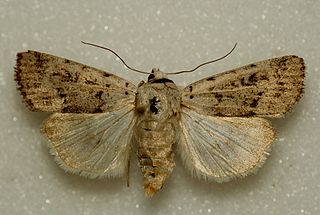
Anicla tepperi is a moth of the family Noctuidae first described by Smith in 1888. It is found in North America from eastern Manitoba west to the Alberta foothills, north to about Lloydminster and south to southern Colorado.

Apamea cinefacta is a moth of the family Noctuidae first described by Augustus Radcliffe Grote in 1881. It is found in western North America, including in Washington and Alberta.

Apamea commoda, the southern Quaker, is a moth of the family Noctuidae. The species was first described by Francis Walker in 1857. It is native to North America, where it is distributed from Nova Scotia west across southern Canada to southern British Columbia, north to Alaska and Yukon Territory, and south at least into Manitoba.
Apamea contradicta, the northern banded Quaker, is a moth of the family Noctuidae. The species was first described by Smith in 1895. It is native to northern North America, where it can be found across southern Canada from Newfoundland and Labrador west to Alberta and south to Colorado.
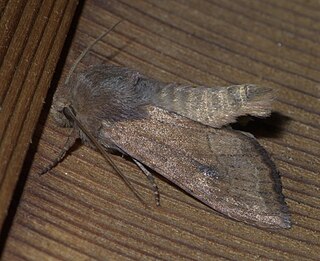
Apamea inficita, the lined Quaker is a moth of the family Noctuidae. The species was first described by Francis Walker in 1857. It is native to North America, where it can be found from Newfoundland west to British Columbia, north to the Yukon and the Northwest Territories, and south to Colorado.
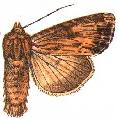
Apamea lignicolora, the wood-coloured Quaker or wood-coloured apamea, is a moth of the family Noctuidae. The species was first described by Achille Guenée in 1852. It is native to North America, where it is distributed across much of Canada and the United States.

Apamea longula is a species of moth in the family Noctuidae that was first described by Augustus Radcliffe Grote in 1879. It is found in western North America, mostly from California to the Great Plains. There are also a few records from areas north, including Alberta, Yukon, and Alaska.
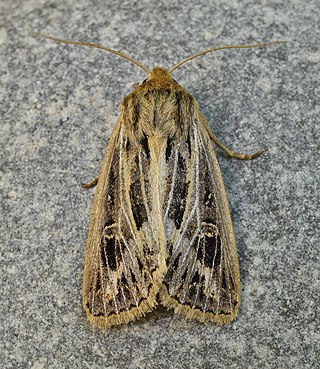
Apamea niveivenosa, the snowy-veined apamea, is a moth of the family Noctuidae. The species was first described by Augustus Radcliffe Grote in 1879. It is native to northern North America, where it can be found across Canada and south to California.
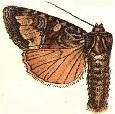
Apamea occidens, the western apamea, is a moth of the family Noctuidae. The species was first described by Augustus Radcliffe Grote in 1878. It is native to western North America as far east as Alberta and Kansas.

Apamea plutonia, the dusky Quaker or dusky apamea, is a moth of the family Noctuidae. The species was first described by Augustus Radcliffe Grote in 1883. It is native to northern North America, where it occurs across the boreal regions, with some occurrences from as far south as New Mexico and Pennsylvania.

Apamea scoparia is a moth of the family Noctuidae first described by Kauri Mikkola, Tomas Mustelin and J. Donald Lafontaine in 2000. It is one of the most common and widespread North American Apamea, being distributed from Newfoundland and Labrador to Alaska and British Columbia, and south to California and Arizona.

Apamea spaldingi, or Spalding's Quaker, is a moth of the family Noctuidae. The species was first described by John Bernhardt Smith in 1909. It is native to interior western North America.

Euxoa siccata is a species of moth in the family Noctuidae that was first described by Smith in 1893. It is found in North America, including Alberta and Colorado.

Apamea zeta is a moth of the family Noctuidae. It has a Holarctic distribution, and can be found throughout the Northern Hemisphere. It occurs throughout Europe and the northern half of North America.
Cryphia olivacea is a moth of the family Noctuidae first described by Smith in 1891. It is found in North America from British Columbia, south to California.
Euxoa aurulenta, the dune cutworm, is a moth of the family Noctuidae. The species was first described by Smith in 1888. It is found in North America from Ontario west to Alberta and Washington, south to Illinois, Nebraska, Colorado and Arizona.
Phalaenostola hanhami, also called Hanham's owlet or Hanham's snout moth, is a litter moth of the family Erebidae. The species was first described by J. B. Smith in 1899. It is found in North America from Nova Scotia, west across Canada to central Alberta, south to Massachusetts and New York.











